My journey on Wednesday, 19th October 2016
The direct service from Wolverhampton to Manchester is currently operated by Cross Country, using 'Voyagers'. The whole of my journey would be 'under the wires' but using diesel traction. The 09:15 from Wolverhampton was a 4-car set and we made good time to Stafford, where we stood for 5 minutes. The new Norton Bridge Flyover came into use on 29-Mar-2016, so we were routed via the Slow Line (now upgraded for 100 m.p.h. running) to Norton Bridge where we diverged to the left onto the new Down Manchester, rising at 1 in 125, before crossing over the four lines of the West Coast Main Line and rejoining the 'old' line to Stone.
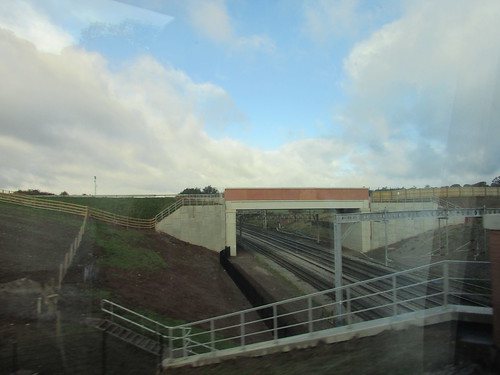
View of WMCL from Down Manchester train.

Revised layout at Norton Bridge (Rail Engineer).
[Click on image for larger view]
We made a very slow approach to Stone, finally coming to a stand at signal SOT 411, part way along the curving platform, watched by passengers waiting for a following stopping train. After a few minutes, a Virgin 'Pendolino' scurried past on the Down Line from Colwich and our signal cleared. By the time we had reached the next signal, it was already 'green' and we had a succession of 'green' aspects until we approached Stoke and passed the former Marcroft Engineering, now Axiom Rail and a DB Schenker company. We came to a dead stand just outside the station before being admitted to the platform and, by the time we'd completed station duties and set off, we were about five minutes 'down'. Our next station stop was Macclesfield, where a crowd of passengers joined the train. We'd not recovered any of our lost time when we approached Bramhall and we were once again stopped by an adverse signal.
I always think the design of the signal heads on the Manchester South scheme rather odd. They are the usual modern 4-aspect types using Light Emitting Diodes projected through two 'lenses' but provided with a shaped hood which includes a rectangular tab hanging down inside. I assume the tab is to prevent low sun reflecting off the lens. I believe the signals were supplied by Ansaldo.

Bramhall: Signal MS 385 (sorry about the reflections from the brightly-lit coach interior).
In a while, the signal cleared and we continued at a modest pace to Cheadle Hulme, where we were once again stopped by signal MS 391 sited towards the end of the sharply-curved platform. Presently, we continued to our stop at Stockport, arriving over ten minutes late. We had no further delays on the short journey to Piccadilly. I can't recall an earlier trip from Wolverhampton to Manchester which suffered four signal stops, but on our arrival the Guard only made the usual non-committal comment over the public address regretting our late running and no explanation was offered.
Around Manchester
With a little under three hours before I needed to be at the Museum, I'd decided to make a quick trip to Rochdale to see how the railways had changed. This involved a train from Manchester Victoria so I descended to the Undercroft at Piccadilly which houses the Metrolink tram station. In 2013, I'd seen some of the non-public areas of the Undercroft during a fascinating visit to the Piccadilly Signalling Control Centre, described here (with links to pictures).
I purchased a 'Train and Tram Daysaver' ticket from one of the Ticket Machines on the platform to cover my explorations. Since I first travelled on Metrolink, the network has expanded remarkably - there's a System Map here. My tram was the third to arrive and I sat near the front as we rumbled through the streets, pausing briefly at Piccadilly Gardens, Market Street and Shudehill before arriving at Manchester Victoria.
Victoria tram and train station had changed out of recognition since my earlier visit on 12th March 2013. The station was remodelled in the 1990s when Metrolink took over the former electrified railway line to Bury, and a two-platform tram station huddled under the old train sheds, adjacent to the remaining British Rail terminal platforms. The tram station now has three, improved platforms and, just outside the station, there's a junction leading to a temporary new terminus at Exchange Square. This is part of the Second City Crossing project (inevitably abbreviated to '2CC') which, in the future, will continue to a junction with the existing route at St. Peter's Square.
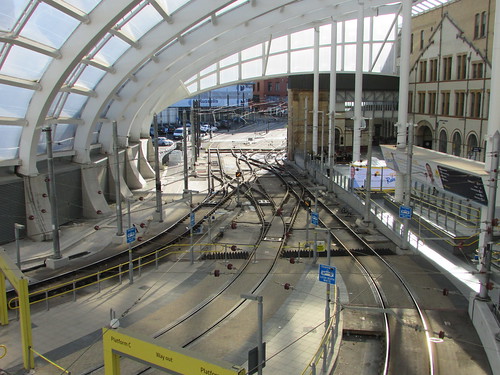
Manchester Victoria Tram Station looking towards Piccadilly Gardens. The new '2CC' route can be seen diverging to the right.
The enlarged tram station formed part of a 44 million pound station upgrade, completed in October 2015, of which 20 million pounds was spent on a modern, airy overall roof, clad in some sort of semi-transparent fabric, covering the Tram Station, the Terminal Platforms and the Concourse area. The old train sheds have been removed (although the outline of the gables can still be seen on the wall of the main station building facing the platforms) to make way for the modern roof. I noticed a worker (in hard hat and orange High Visibility overalls) walking across the outside of the new roof but the significance of this wasn't apparent until I later discovered that, following a rainstorm on the afternoon prior to my visit, several roof panels above platforms 1 and 2 had fallen to the ground, soaking numerous people with rainwater and injuring two. That discovery rather limited my admiration for the improvements but I suppose all this investment in roofs which cannot withstand normal English weather is to be expected in a country which so mismanages its capital projects.
The following two pictures show the stone facade of the road elevation of the 1909 station building and the rear elevation of the same building with the new roof.
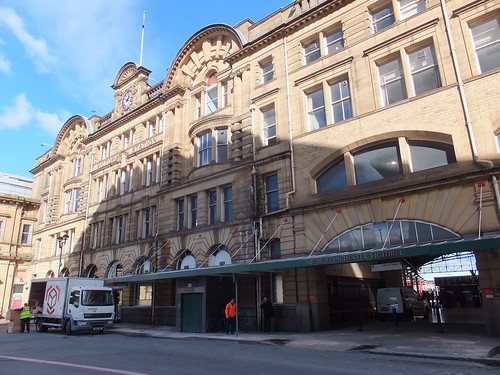
Manchester Victoria's elegant facade by William Dawes, provided for the station extension of 1909, viewed in 2013.
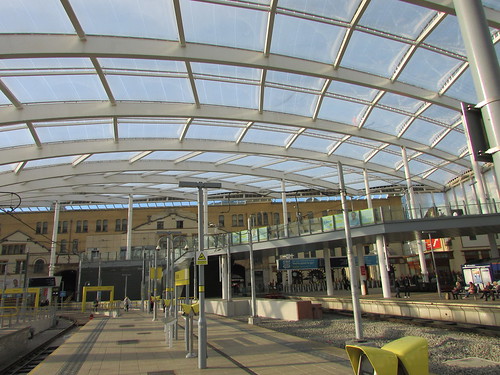
Manchester Victoria: Platform elevation of the 1909 station building, showing the new roof viewed from the Metrolink platforms in 2016. The elevated walkway leads to the Manchester Arena.
The following two pictures show part of the concourse area before and after the traditional glazed roof was replaced by the new roof.
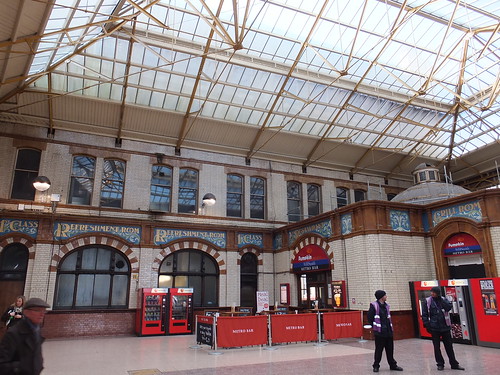
Manchester Victoria concourse area in 2013, showing the traditional glazed roof.

A similar view (taken from the elevated walkway to the Manchester Arena) after construction of the new roof.
Politicians are now fond of calling Lancashire and Yorkshire "The Northern Powerhouse", so I went to platform 1, eager to see what type of train was deemed suitable for the Leeds service, running non-stop to Rochdale - it was a 2-car Class 142 'Pacer'. I'm not a fan of diesel railcars built of bus parts but we lolloped along (as 4-wheel long-wheelbase vehicles do) gamely enough, making noisy progress at full throttle with the folding power doors (and everything else) rattling and the wind howling under the doors, arriving at Rochdale right time.
I knew that the station had been completely rebuilt and that Rochdale can also be reached by Metrolink tram, but, after a quick look at the modernised streetscene outside the station, I decided to defer exploration of the town centre until a later visit and return to Manchester Victoria. However, I was struck by the foreign appearance of the Church of St John the Baptist built in 1927 in Byzantine Revival style and listed Grade II*.

View outside Rochdale railway station. The domed building is St John the Baptist Roman Catholic church.
Waiting for the return service, I could just make out evidence of the platforms of the earlier, larger station. The new station is a simple island with a bay which I presume once serviced the Oldham branch, now part of the 'Metrolink' network. However, there's a new bay at the Manchester end which hasn't yet been brought into service. As recently as 2013, there was a signalbox called 'Rochdale West' (code 'TH') but the modern 4-aspect colour light signal I could see was numbered 'TH 7300', suggesting that control has been transferred to the Rail Operating Centre at Ashburys.

Rochdale. View from end of Up platform looking towards Manchester, with the new bay platform on the right.
The train back was a well-patronised Class 158 but the return journey took a little longer as we made stops at Castleton, Mills Hill and Moston. I look a few more pictures at Victoria, as 66 708 hustled a freight westbound through platform 4. In addition to the terminal platforms 1 and 2, there remain four bi-directional through platforms. Platforms 3 and 4 have some daylight above, but platforms 5 and 6 are buried beneath the massive bulk of the Manchester Arena. To look at the 'western approaches' to Victoria, I headed towards a diesel multiple unit forming the 12:10 to Wigan Wallgate standing in platform 3, which took off before I reached it.
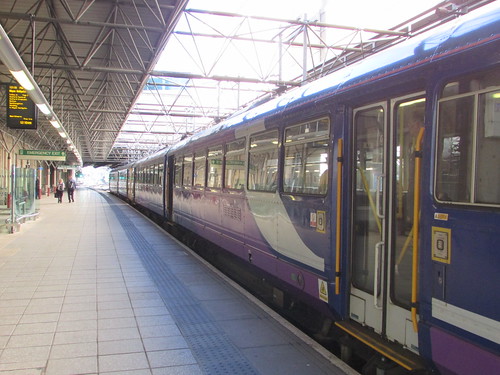
Manchester Victoria: The 12:10 for Wigan Wallgate leaving platform 3.
However, I caught the 12:14 off platform 4 for Kirkby, via Wigan Wallgate. The four lines to Deal Street Junction now have Overhead Line Equipment and the junctions appeared to have been further simplified.
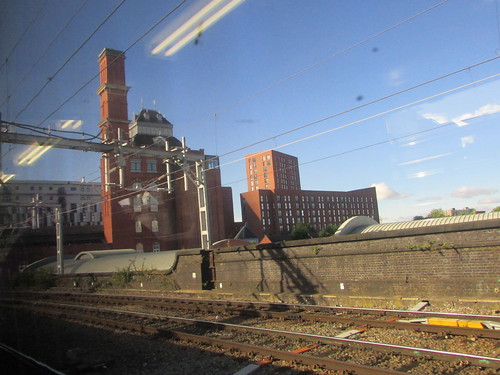
Manchester area rail: Approaching Deal Street Junction, with the former Threlfall's Cook Street Brewery (now Deva City Office Park) in the background.
We made a quick stop at Salford Central, overdue to be electrified as part of the electrification to Blackpool, then continued past the Hope Street Cement Discharge Sidings on our left to Salford Crescent where the line from Ordsall Lane Junction trailed in, also on our left. We made our second stop at Salford Crescent, where I got off on the single island platform to watch my train disappear on the Atherton Line, heading for Kirkby. I was reminded of the trip I made along the Kirkby Line on 9-Aug-2014, described here.
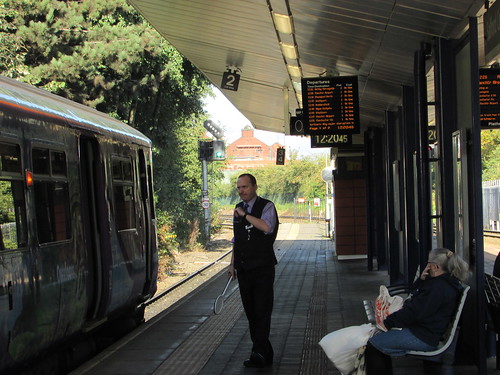
Salford Crescent, with 12:21 to Kirkby about to leave platform 2. Signal MP 405 is showing 'green' with a 'white feather' for the Atherton line diverging to the left, to which a 30 m.p.h. limit applies, as shown by the reflective sign and arrow on the signal post.
I'd originally intended to re-trace my route back to Manchester Victoria but I discovered that in 5 minutes there was a Manchester Airport service stopping at Deansgate which was a simpler option. Leaving Salford Crescent, we took the right-hand route, leading to Ordsall Lane Junction where we crossed the original Liverpool and Manchester line (now called the Chat Moss line). As we continued to Castlefield Junction, on the left I could see the elaborate civil engineering works involved in the construction of the new Ordsall Chord with the Museum of Science and Industry in the background.
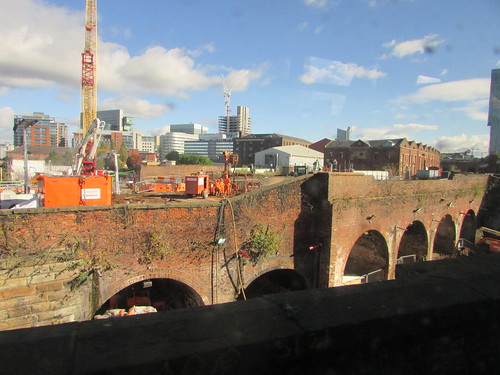
Approaching Deansgate from Salford Crescent. The 1830 Warehouse at the Museum of Science and Industry is visible in the background.
From Deansgate station, I walked to the Museum.
The Journey Home
After the 'unveiling' at the Museum, I walked back to Deansgate station but, with no train to Piccadilly for over half an hour, I took the pedestrian walkway across Whitworth Street to reach Deansgate-Castlefield Metrolink station, which I remembered with two staggered platforms. This station had also been rebuilt since my last visit, now having three platforms and pointwork allowing arrivals from either direction to 'turnback'. In fact, one tram from Cornbook direction did just that in the few minutes I waited for a Piccadilly service.
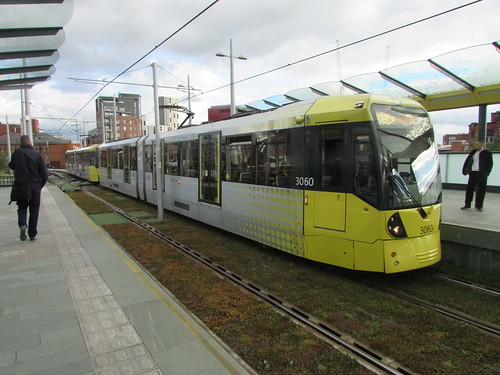
Deansgate-Castlefield with a 'double' unit arriving from St. Peter's Square direction.
On arrival at Piccadilly, I discovered I just had time to jump on the 15:27 Cross Country 'Voyager' to Bournemouth via Wolverhampton. We made our first station stop at Stockport and then were stopped by signals at Edgeley Junction No. 1. The signal cleared after a diesel multiple unit growled past on the down, so I suspect they'd crossed the diesel in front of us from the Buxton Line. But I've no idea why we were stopped again before the junction at Cheadle Hulme. Once under way again we had no further signal delays and, after our booked stops at Macclesfield, Stoke-on-Trent and Stafford, we arrived at Wolverhampton about 'right time', allowing me to catch the last bus home. After recent timetable changes, this is now at the ridiculously early time of 17:10!
Origins of the railways around Manchester
The tangle of railways which developed around Manchester, many of which are still in use, is perhaps better understood by looking at the pre-grouping map below.
I'd arrived that morning at Piccadilly (originally London Road) on what was the London & North Western Railway. The Metrolink network is, of course, modern. My trip to Rochdale and Salford Crescent were on the Lancashire & Yorkshire Railway, which merged with the London & North Western Railway shortly before the grouping. My journey from Salford Crescent to Ordsall Lane Junction and on to Deansgate (originally Knott Mill & Deansgate) only became possible in 1991 with the opening of the Windsor Link and a new interchange station at Salford Crescent.
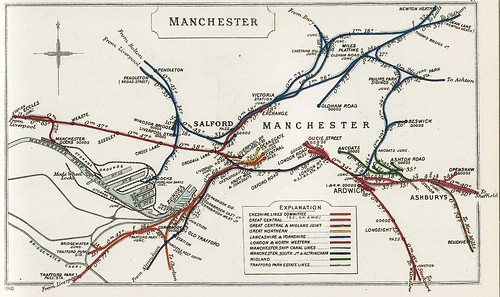
Railway Clearing House Map of Pre-Grouping Railways around Manchester dated 1910, showing London & North Western lines in red, Lancashire & Yorkshire lines in blue.
Click for other sizes or to download
Related posts on other websites
Improvingements Stafford - Crewe (Network Rail).
Norton Bridge rail flyover opens.
Easing the Flow (Rail Engineer).
Manchester Victoria station (Wikipedia).
Manchester Victoria (MCV) (National Rail).
Related posts in this blog
By Rail to Manchester.
Manchester Piccadilly Station - Behind the Scenes.
My pictures
Stafford Area rail.
Stoke Area Rail.
Manchester Area Rail.
Manchester Metrolink.
